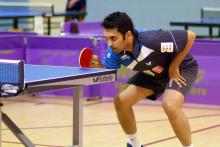I would like to briefly make some comments about the table tennis stance, then illustrate my final point by showing you a couple short video clips.
Toes
When your coach tells you to stay on your toes, what does he mean?
He means that he wants your racket out in front of your body, knees bent, leaning forward at the waist, and slightly on the front half of your feet – on the balls of your feet. He does not mean that you should take up ballet. If you stay too much on your toes (as in ballet), you will not be able to make the big jumps because you will have no spring from the ankles. Your heals should be approximately ¼ of an inch off the ground so that a sheet of paper can be slid under your foot to the half way point.
Width
The width of your stance is somewhat personal preference. A narrow stance makes it easier to make small jumps, and a wider stance makes it easier to make bigger jumps. This is the reason that most girls have a narrow stance (because they stay close) and most guys have a wider stance (because they play slightly further from the table).
Balance
The key to balance is standing slightly on the inside of your feet without buckling your knees. Ask any player over 2500 to see the bottom of their shoes. I guarantee that you will see wear on the inside, not the outside, of the shoe. I sometimes see players topple over to the ground at the club, these are usually the players standing on the outside of their feet.
Transition
This is the tricky part. What is the correct stance for backhand and what is the correct stance for forehand?
The correct stance for backhand is the stance that you can hit your backhand to any location on the table. The correct stance for forehand is the stance that you can hit your forehand to any location on the table. For beginners, most coaches teach perfectly facing the table for backhand, and slightly open stance for forehand (for righties, this would be keeping the right foot slightly back for forehand). This transition is somewhat necessary for beginners. HOWEVER, the pros have changes this in recent years due to the increased speed of the game in the last 10-20 years. There is no longer a difference in backhand and forehand stance. The foot positioning for both backhand and forehand stays EXACTLY the same. By turning the shoulders slightly in either directly, the pros can hit all their backhands and all their forehands to any location without changing the stance. I’ll illustrate my final point here by showing you 3 short videos:




